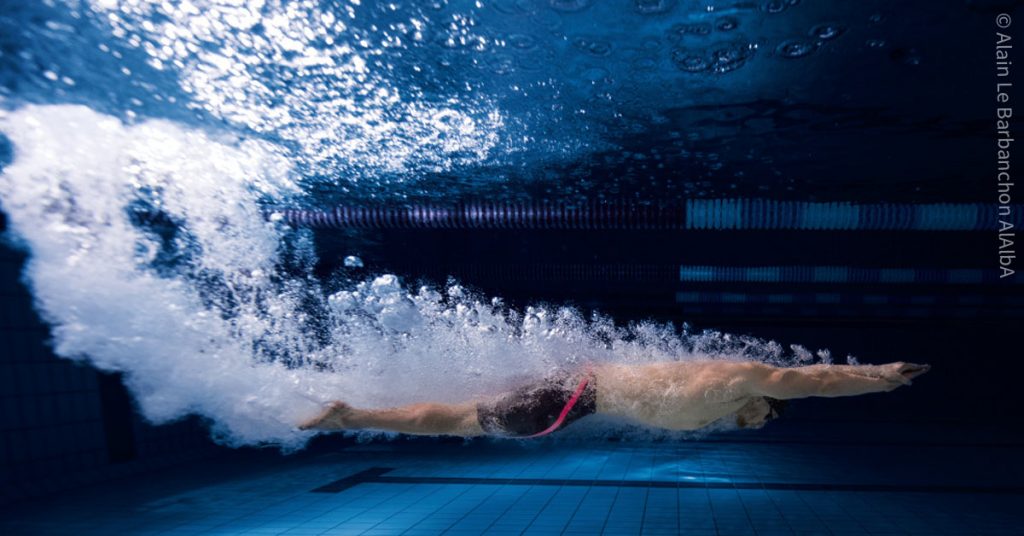v = (Pm*Ep)/D
At first this strange formula would appear to have nothing to do with swimming in a pool, but science tells us that a swimmer’s speed is studied and measured based on these letters; just for fun, let’s try and interpret them and we will see they have something to teach us.
(v) SPEED
v stands for swim speed and so we are talking about the average distance travelled over a set period of time; to make that clearer, if somebody swims 100 metres freestyle in a minute, they will cover 1.666 metres per second or travel at 6 km/h, which would be considered a good walking speed on dry land, but is close to the speed of a small motor boat in the water..
However, it is difficult to talk about average speed in swimming, because the power coming from a swimmer’s limbs makes them move forward in continual “accelerations and decelerations” and… if we take into consideration, for example, the start and turns, their top speed is over double their average speed in a race. This explains why a swimmer has just one goal in a race: “to slow down as little as possible”.
(Pm) MECHANICAL POWER
Pm (mechanical power) is the power a swimmer “exerts” in the water. In this case, it is only logical to make comparisons with a machine. Power determines the amount of energy that can be used over a set length of time; this involves our muscles and their ability to contract into one single effort or a series of repeated efforts, i.e. the number of arm and leg movements performed in a race.
When swimming freestyle with an arm turnover rate of approximately 50 strokes per minute and up to 6 times that number of leg kicks travelling at an average speed of around 2 m/s, our engine can work at a power of approximately 500/800 W, which, in theory, could light a neon bulb for 4 hours or an energy-saving bulb for 40 hours.
(Ep) PROPELLING EFFICIENCY
Ep (propelling efficiency) is a measure of a swimmer’s technique. It is a biomechanical parameter, which, in hydraulics, is used to assess how well a machine works. For example, it is used to test whether a certain size of propeller is ideal for driving a given boat along at maximum speed or whether a paddle, oar or fin has the right surface area to propel a flow of water at the right speed.
The underlying principle is quite simple: if an oar propels water at a certain speed and the boat travels at the same speed, the oar is said to be working at maximum efficiency or, in other words, 100% with no wastage. But 100% efficiency is impossible in water, because the fluid in question is not in a compressible state and does not offer much resistance. Even fish, which have evolved to attain the highest levels of adaptation to their environment, cannot exceed 90% swimming efficiency.
So, what about humans?
Well, it is safe to say that we are rather disappointing swimmers…….. A human being’s propelling efficiency is just 50%. This means that half of the exertion involved in swimming drives a person forward and the other half….. is wasted on pushing water behind them! Considered in these terms, it would seem that, at the beginning of the evolution of the species, man was not an aquatic creature. However, even though from this viewpoint things are not very encouraging, let’s try and see the glass half full: there is definitely an enormous amount of room for improving our technique; not surprisingly, world records keep on falling at a staggering rate, particularly when we consider how infrequently world records are beaten in athletics!
If a swimmer with average technical efficiency (i.e. 50%) capable of swimming 100 m freestyle in 59 seconds (at 1.695 m/s) could improve their technique by 3% at the same level of exertion, i.e. expending the same amount of energy, they would waste less and reach a speed of 1.729 m/s or, in other words, a time of 57.22 secs (no mean feat!).
(D) DRAG
D stands for Drag, which might be described as “friction”. The resistance encountered, for example, when walking along the bottom of a swimming pool is 800 times higher than that encountered when walking at the same speed on dry ground completely immersed in the “fluid we call air”. For a swimmer, this simply means: “improve your swimming position in the water and you will go faster at the same effort”.
D is the denominator in our formula and speed increases as it decreases. There is plenty of room for improvement in this respect: take, for example, the magical effects of so-called “superman” swimsuits, which certainly caused chaos in the world of swimming, because they allowed swimmers to go faster without any extra engine power.
Perhaps the strange formula we began with is now becoming clearer.
There are three ways of swimming faster, which can be used separately or combined together:
1. increase your energy power through regular training based on exertion/rest (we should never forget our organism grows stronger when it rests after exertion, not during exertion), proper nutrition, a healthy lifestyle and increasing the force and timing with which our muscles contract.
2. improve your technique, so as to waste less energy in the water and use the energy available as effectively as possible;
3. reduce Drag by opposing less resistance to forward motion, striving to find the most “hydrodynamic” position in the water and by eliminating any useless or ungainly movements.
